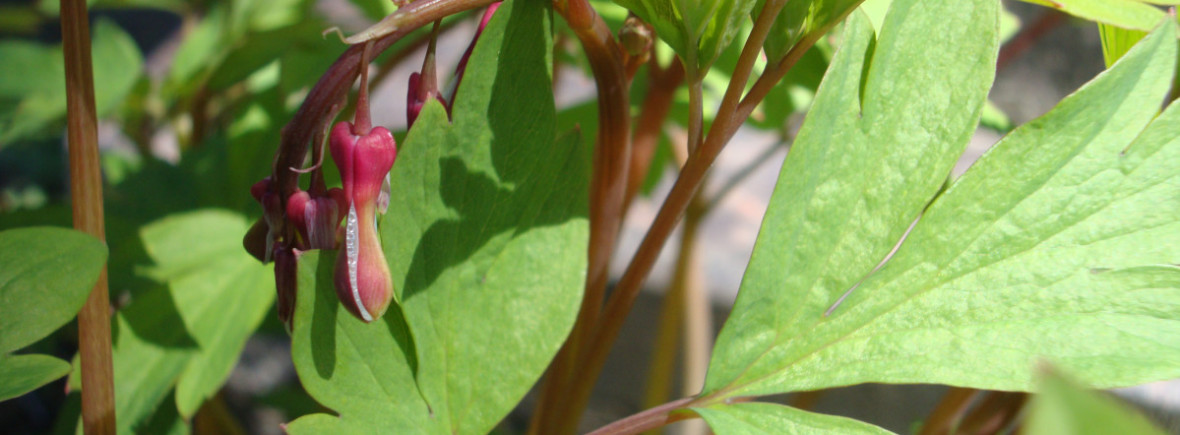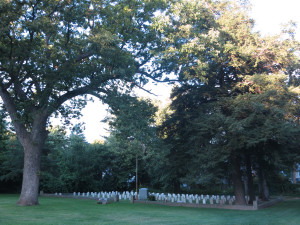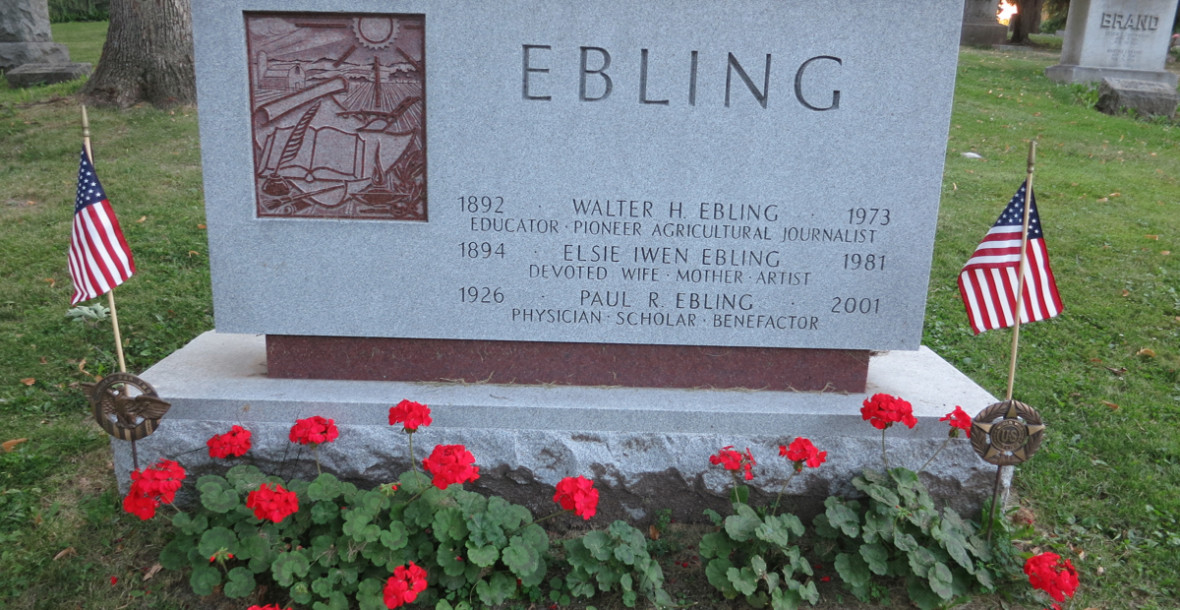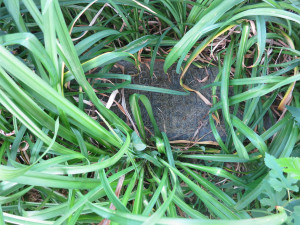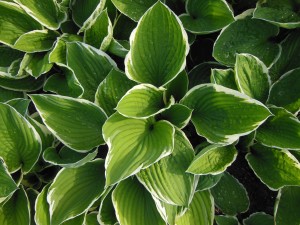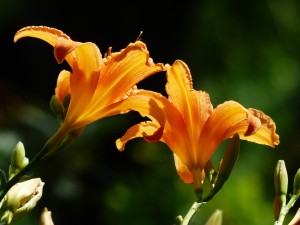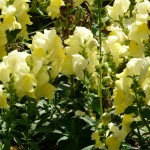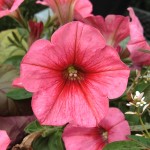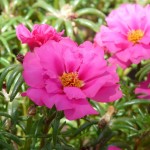This is a guide to the landscape experience of Forest Hill Cemetery, via the historic plant communities and design traditions that have shaped this place. We encourage reflection on how ecological processes and human imagination facilitate encounters with the sacred.
Encountering Ecology
Try to imagine what the designers of Forest Hill Cemetery might have seen when they first came to this site and envisioned a final resting place for the community. A rolling sea of gold and purple grass extends around you in all directions. You don’t have to walk very far to find a gnarly oak tree to sit beneath, its limbs stretched wide out in the abundant light, offering sun-dappled shade. As you take your seat among the acorns, you look out and glimpse shining blue water. This is where you will plan a sacred space.
What did the original designers of Forest Hill Cemetery see when they first visited this site?
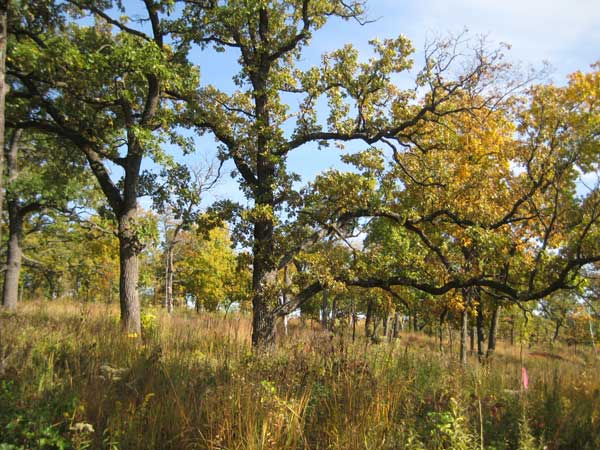
Oak savanna. Photo by Steepcone. ((Steepcone (nd). Bur-oak-savanna-fall. Licensed under CC BY-SA 3.0 via Wikimedia Commons. Retrieved from: http://commons.wikimedia.org/wiki/File:Bur-oak-savanna-fall.jpg#/media/File:Bur-oak-savanna-fall.jpg))
With the help of survey records, knowledge of plant community types, and a little imagination, we can see why this site appealed to the original planners of Forest Hill Cemetery. Early surveyors described the land as rolling terrain with scattered white, black, and bur oak trees. ((Lyon, O. (1834, December). Interior field notes. Public land survey entry. Retrieved from Board of Commissioners of Public Lands : http://digicoll.library.wisc.edu/cgi-bin/SurveyNotes/SurveyNotes-idx?type=article&byte=4059965&twp=T007NR009E.)) When the cemetery was officially founded in the 1850s, this parcel sat several miles outside of the city of Madison and likely did not show much visible evidence of European-American impact (for more information on how Native people had already shaped this landscape, see the Effigy Mounds page).
Prior to its development as a cemetery, this oak savanna would have been maintained by fires sweeping across the undulating landscape, their flames keeping less heat-adapted plant competitors at bay. Once among the most common plant community types in southern Wisconsin, few original oak savannas remain in our state today. Agriculture, grazing, development, and fire suppression have led to its sharp retreat from the dominant land cover in this area. Many native plant and animal species that once found their habitats in this community type are now endangered.
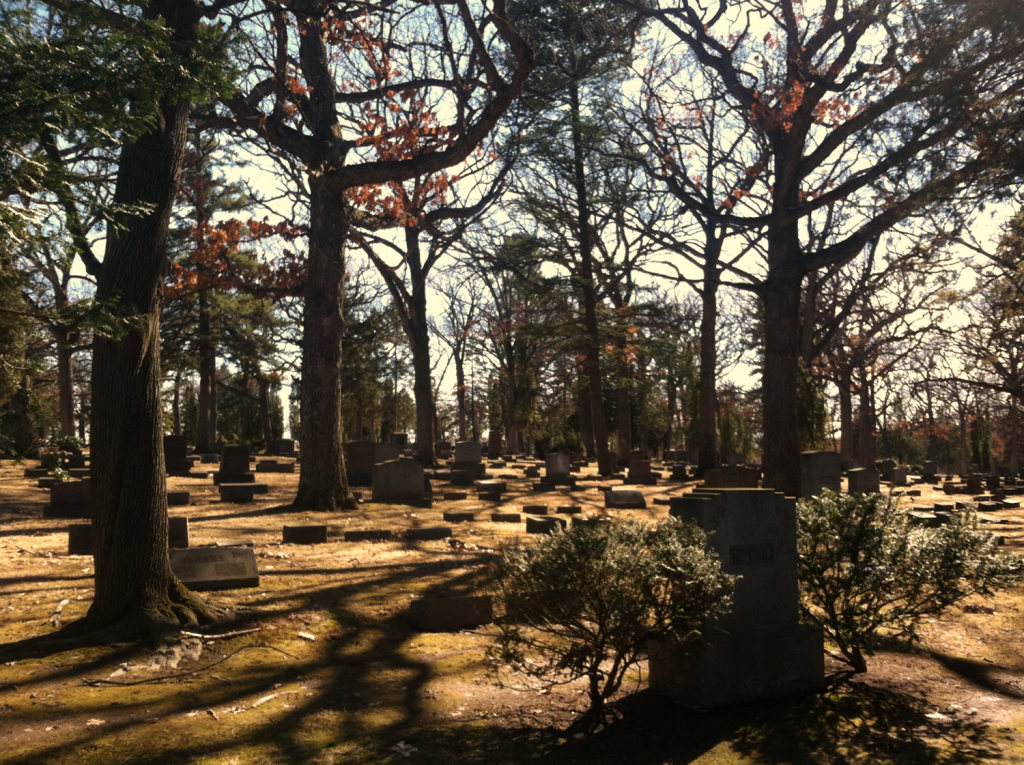
Many sections of Forest Hill retain the savanna characteristics of open space and occasional large trees. Photo by Claire S. Bjork
One surveyor labeled the land that would become Forest Hill Cemetery as “second rate,” but his eye would have been towards more commercial prospects like agriculture and timber production. George B. Smith, mayor of Madison from 1858 to 1861, had a more visionary response to the site, calling it “high and sightly, overlooking the entire city and surrounding lakes” and concluding that “no more appropriate place could be selected for the burial of the dead.” ((Historic Madison, Inc. (1993). Forest Hill Cemetery: A walking tour. Retrieved from: http://www.cityofmadison.com/parks/documents/ForestHillWalkingTour.pdf)) Representatives from the Argus and Democrat had a similar impression when they visited the grounds in 1858:
We were pervaded with a romantic feeling as, standing upon one of the long mounds that crown the brow of its loftiest knolls, we surveyed the sunny, silvery, enchanting landscape spread out around us. Seldom have we witnessed more lovely or more majestic natural features. The spot is well worth a visit. It will form a quiet Sabbath retreat to the living as well as to the dead.
—Argus and Democrat, March 30, 1858 ((Forest Hill Cemetery Committee of Historic Madison, Inc., (2002). A Biographical Guide to Forest Hill Cemetery: The Ordinary and Famous Women and Men Who Shaped Madison and the World.))
Noting the convenience of the location for visitors and the praising the lovely views it offered, they also remarked on how easy it would be for skilled landscapers to shape the parcel of land “as it is in its primitive state, almost– covered with trees and many other native ornaments” into a fitting memorial for the dead.

1834 public land survey notes. Source: Board of Commissioners of Public Lands. ((Copyright © Wisconsin Board of Commissioners of Public Lands, and the University of Wisconsin Board of Regents. Retrieved from: http://digicoll.library.wisc.edu/cgi-bin/SurveyNotes/SurveyNotes-idx?type=article&byte=4059965&twp=T007NR009E))
Designing a Sacred Landscape
The founders had a two-fold purpose in mind. To provide a simple burial space was not the sole aim, but they also desired to create a burial space that was quiet and peaceful away from the turmoil and noise of the city.
With our fore-fathers’ aim in mind, the Commissioners feel that in careful planning and cultivation of the simplicity and beauty of nature, they have developed and carried out the wishes of those who devoted their time and energy to create a lasting natural memorial to loved ones.
–Forest Hill Cemetery pamphlet, ca. 1930 ((Cemetery Commission. (193-?). Forest Hill Cemetery. Government pamphlet. Available at Wisconsin State Historical Society Library.))
The Romantic Cemetery
Forest Hill Cemetery is often described as a romantic or rural cemetery. The rural cemetery movement drew on the English landscape garden style, which emphasizes scenic, meandering views rather than geometric composition.
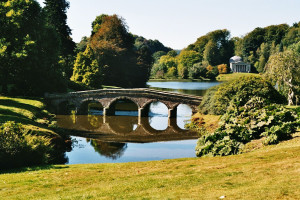
- Stourheard Estate in Wiltshire embodies the picturesque English landscaping approach. Photo by Lechona. ((Lechona (nd). Stourhead Garden. Licensed under CC BY-SA 3.0 via Wikimedia Commons. Retrieved from: http://commons.wikimedia.org/wiki/File:Stourhead_garden.jpg))
Inspired by romantic poets and painters who celebrated the beauty and moral significance of nature, the English naturalistic style (embodied in the sublime, picturesque, and beautiful design aesthetics) was heartily embraced in America after the Revolutionary War. ((Rieley, W. D. (1961). Traditional gardens. In G. P DeWolf (Ed.) Taylor’s Guide to Gardening Design. Boston: Houghton Mifflin.)) Poised between the wild, often frightening awe of the sublime and the tamed, manicured landscape of the beautiful, the picturesque is intended to reinforce a sense of wonder in the enveloping power of nature and to remind humans of their impermanence and relative inconsequence in the universal scheme. ((Goodnoe, J. (2013, November). Historic landscape cemeteries: Forest Hills Cemetery. Presentation for the American Society of Landscape Architects Annual Meeting and Expo, Boston, MA. Retrieved from: http://www.asla.org/uploadedFiles/CMS/Meetings_and_Events/2013_Annual_Meeting_Handouts/FS003%20Historic%20Landscape%20Cemeteries%20Outline.pdf)) The picturesque is often used to invoke moral teaching, drawing on the inspiration of nature to promote order and decorum.
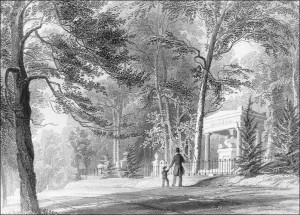
Visitors to Mount Auburn Cemetery are dwarfed by their natural surroundings in this engraving by James Smillie (1847). ((Walter, C. W. and Smillie, J. (1848). Mount Auburn Illustrated. New York: Martin and Johnson. Retrieved from National Park Service: http://www.nps.gov./nr/twhp/wwwlps/lessons/84mountauburn/84mountauburn.htm))
Aside from random, isolated graves established by pioneers, European-American burial sites before the introduction of the rural cemetery consisted primarily of family plots, churchyards, and “potter’s fields” for individuals ineligible for burial elsewhere. ((Sloane, D. C. (1995). The Last Great Necessity: Cemeteries in American History (Creating the North American Landscape). Baltimore: The Johns Hopkins University Press.)) As competition for urban space grew, municipalities in the mid-1800s began to move their cemeteries to the edges of town. Landscape tastemakers, writing in The Country Gentleman magazine, emphasized that the design of these new spaces should not “be left naked and desolate, as were most of the old-fashioned burying yards…but should be a pleasant, cultivated scene.” ((The Country Gentleman (1857). In P. J. Finney, Landscape Architecture and the “Rural” Cemetery Movement. Focus on Global Resources, 31(4). Retrieved from: http://www.crl.edu/focus/article/8246)) Common elements that contributed to this cultivated aesthetic were continuous enclosures of plants or fencing around the cemetery border, dense trees (including evergreens, but not species with droopy limbs, whose mournful appearance was seen to create an overly somber mood) and showy flowering shrubs.

Meandering paths and dense canopy at Forest Hill create the intimate effect of outdoor “rooms.” Photo by William Cronon.
The sensation of feeling lost in the cemetery, which designers achieved with winding paths and enclosures of plantings and gravestones, was purposeful: it enhanced the distance felt between the ‘natural’ cemetery landscape and the nearby urban environment. Visitors from town could enjoy the change of scenery and contemplate the distinction between the perfect order of nature and the human-imposed order of a geometrical city layout. ((Sloane, D. C. (1995). The Last Great Necessity: Cemeteries in American History (Creating the North American Landscape). Baltimore: The Johns Hopkins University Press.))
The natural beauty in rural cemeteries was intended to elicit powerful emotional responses in visitors. Writings about Mount Auburn Cemetery in Massachusetts– the first romantic cemetery in America and the prototype for Forest Hill– make this clear. Founded in 1831, Mount Auburn features many of the same design components such as winding paths, wooded areas, and panoramic views. ((Linden-Ward, B. (1989). Strange but genteel pleasure grounds: Tourist and leisure uses of nineteenth century rural cemeteries. In R. Meyer (Ed.) Cemeteries and Gravemarkers: Voices of American Cultures. Ann Arbor: University of Michigan Research Press.))
Plants were at the forefront of the Mount Auburn design aesthetic, and the experience of place was intended to be that of a botanical garden and arboretum as much as a cemetery.

Père Lachaise in Paris influenced Mount Auburn in Boston, which in turn influenced Forest Hill in Madison. Sources (left to right): Wikimedia Commons. ((Brongniart, A. T. (1813). Plans du palais de la bourse de Paris et du cimitiere Mont-Louis en six planches. Public domain. Retrieved from: http://commons.wikimedia.org/wiki/File:Brongniart_-_Plans_du_Palais_de_la_Bourse_de_Paris_et_du_cimeti%C3%A8re_Mont-Louis,_V.jpg)) NBL Map Center ((Wadsworth, A. (1831). Plan of Mount Auburn. Retrieved from: https://www.flickr.com/photos/24528911@N05/3370528616/)). Google Maps. ((Imagery © 2015 DigitalGlobe, USDA Farm Service Agency, Map Data © 2015 Google))
Romantic cemeteries like Mount Auburn were designed with specific goals in mind for meditation, recreation, and character development. Young people were encouraged to walk among the graves of illustrious figures and to find moral inspiration in the beautiful scenery and the accomplishments of their ancestors. Far enough removed from the city to be free of disturbing sights, sounds, and smells, the rural cemetery was a place to encounter romantic melancholy.
The landscape of Forest Hill Cemetery has changed over the last 150 years, but it retains many of the aesthetic characteristics that the original planners had in mind. In 2014, a writer for the Wisconsin State Journal described the scenery at Forest Hill’s Confederate Rest in evocative terms that would have pleased the cemetery’s designers:
Tucked back from the driveway by a genteel expanse of lawn and shaded by pines and a massive, old oak tree, you can almost hear the spirits of the young soldiers whispering as the wind rustles the leaves on a cool autumn day. ((Newman, J. (2014). Madison in 100 objects: Confederate soldier’s tombstone. Wisconsin State Journal. Retrieved from: http://host.madison.com/news/local/100-objects/madison-in-objects-confederate-soldier-s-tombstone/article_32752c19-31f6-50bd-a2fb-70f57ddf0105.html#ixzz3UVbhT6XO))
Landscape designers working in the romantic cemetery tradition sought to strike a balance between open and closed spaces: large expanses of grass provide a liberating vista, yet are accompanied by the comforting shelter of tall trees, in a visually interesting play between shadow and light.
Elements of a Memorial Park

These sketches show an evolution of cemetery design styles, each of which is present in some form at Forest Hill. From left: the church graveyard; the rural cemetery; standardized veterans’ monuments; and finally, the memorial park. Drawing by Adrienne Hagen.
Near the turn of the 20th century, concerns arose regarding the rural cemetery aesthetic. The lack of uniformity in grave markers could lead to a pattern of one-upmanship and a visually chaotic scene. With the introduction of mechanized equipment for cemetery maintenance, it became increasingly difficult to manage uneven rows of large markers. Flat markers that lay even with the ground became more and more popular, since lawnmowers could pass directly over them. Topography also tended to become more level, to make maintenance easier.
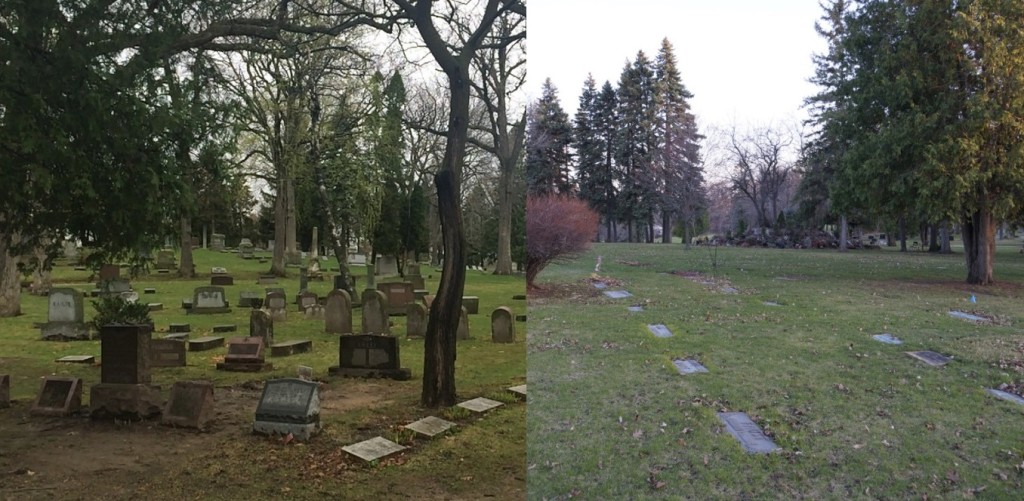
The memorial park sections of Forest Hill (right) were conceived as an aesthetic alternative to older sections (left) that display little uniformity. Photos by Adrienne Hagen (left) and William Cronon (right).
These pragmatic changes led to a more standardized aesthetic within cemeteries. Rather than the picturesque, the memorial park invoked the beautiful, favoring unified artistic expressions over individual and naturalistic ones, manifested in soft lines, regularity, and symmetry. The intentionality and precision of this design was a demonstration of a social commitment to remember those departed.
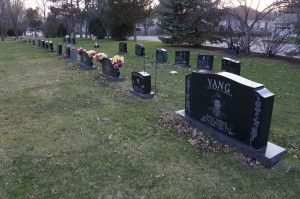
Straight lines and markers of uniform height are characteristic of the memorial park style. Photo by William Cronon.
One hallmark of the memorial park landscape style is the division of sections, or “gardens,” that often have a thematic piece of art at the center. This sectioning creates a more accessible arrangement, yet allows individual communities to select an element that represents and distinguishes them.
A pamphlet produced by cemetery commissioners ca.1930 describes the ‘Park Plan Section’ (section 7) of Forest Hill, and the impetus behind it, as follows:
Many people object to the erection of monuments and markers on their lots, and with the wide-spread innovation of memorial parks, and the increasing demand for this type of lot, the Cemetery Commission opened a section in which there are no visible monuments. Bronze plaques mark the graves and designs are subject to the approval of the Superintendent.
This section is landscaped with trees, evergreens, roses, and many other species of low flowering bushes. Near the center of this area is a bird bath pyramid planted with colorful flowers and beautiful bushes. Extending from the bird fountain on the north and south are planting strips with colorful flowers, which are in bloom from Spring until Fall. ((Cemetery Commission. (193-?). Forest Hill Cemetery. Government pamphlet. Available at Wisconsin State Historical Society Library.))
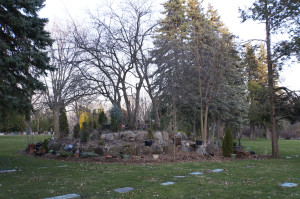
A landscape mound (the “bird bath pyramid” mentioned in the quote above) surrounded by flat markers in Forest Hill, section 7. Photo by William Cronon.
While it is unclear exactly when hybridized turf grass was introduced to Forest Hill, this element is another hallmark of the memorial park design tradition. The use of turf grass is one of the most notable features of the standardized, clean cemetery appearance; the Capital City Parks blend that is used at Forest Hill is described by its distributor as being “formulated to thrive” with a “high quality look and feel.” ((Heritage Seed Company (n.d.) Capital City Parks: Premium turfgrass mix. Retrieved from: http://www.heritage-seed.com/sites/heritageseed/uploads/documents/Capital_City_Parks.pdf)) This particular grass blend is used throughout parks in Madison and the Midwest, and further situates Forest Hill as recognizable and familiar in the larger community and region.
Landscaping Today: Careful Maintenance
Today, landscaping decisions are made by a team that includes representatives from the Madison Parks Department and Forest Hill Cemetery. The group operates under the philosophy that Forest Hill, despite its unique operations as a cemetery, is essentially a park. Native plants are considered to be more in keeping with the time-honored character of Forest Hill, and its designation as a historic site continues to influence decisions about its aesthetics and ecology.
Forest Hill managers cite the importance of large trees and overhead canopy as a way of ensuring that the originally intended experience of the cemetery is preserved. Accordingly, managers in recent years have moved away from flowering, non-native shrubs and small trees in favor of larger native trees such as species of oak and maple. Plantings such as arborvitae are allowed to age naturally, but they are not replaced after they die.
Trees that you will see in Forest Hill include:
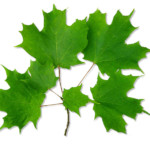
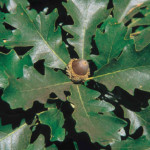
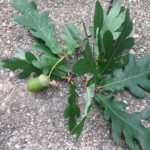
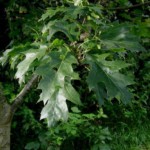
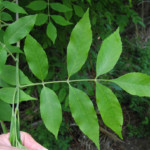
A number of Forest Hill’s older trees were uprooted in a large storm several years ago, and others have been removed due to age or poor condition. While no major tree diseases have yet struck the site, plans are in place to remove all ash trees to discourage the spread of the devastating emerald ash borer. Replanting the cemetery with new trees is complicated by space limitations, as the majority of the remaining open land has already been purchased by individuals for future grave sites. For the most part, new trees are inserted where old trees have faltered or died, with the stumps of old trees ground down to allow young saplings to be planted.
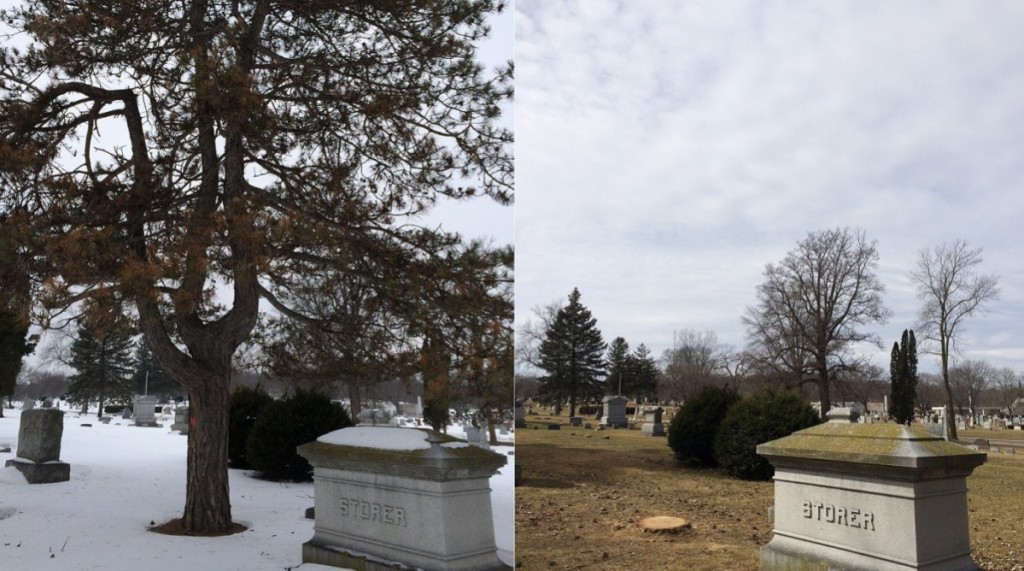
The presence or absence of a single tree can change the view considerably, as seen here in photographs of the Storer plot taken one month apart (February and March 2015). Photos by Adrienne Hagen.
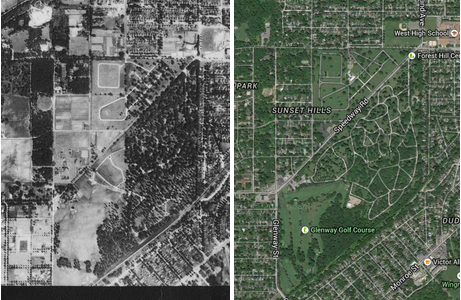
Satellite imagery from 1937 and present-day show reductions in tree density in much of Forest Hill. Source (left to right): USDA. ((USDA (1937, June 6). Public domain. Retrieved from WI Historic Aerial Image Finder: maps.sco.wisc.edu/WHAIFinder)) Google Maps ((Imagery Copyright 2015 DigitalGlobe, USDA Farm Service Agency, Map Data Copyright 2015 Google))
A major maintenance task in the cemetery is mowing. While the use of flat grave markers in some sections makes this process easier, markers and tree roots can shift over time and rise above the ground surface, becoming susceptible to damage by lawnmower blades.

Turf grass is not ubiquitous in the cemetery. Here, a soft carpet of moss surrounds a grave. Photo by Claire S. Bjork.
New grass seed is regularly required, notably after a new grave is filled. When possible, efforts are made to cut and remove the sod in order to replace it after the grave is refilled with earth, but this turf often fails to re-establish and new seed is needed.
Perpetual Care
Early in the cemetery’s history, commissioners expressed concern about future maintenance of the beautiful site, but especially of the burial lots themselves:
The Commissioners urge upon every one, the importance of making provision for the future care of lots in Forest Hill Cemetery, to insure perpetual maintenance, repair and preservation, and also to avoid the possibility of leaving lots neglected forever. …This appeal is made because of the concern felt regarding the future of Forest Hill Cemetery, and the fear that this beautiful cemetery may ultimately be abandoned if those who should be most interested, fail to provide for its maintenance. ((Cemetery Commission. (193-?). Forest Hill Cemetery. Government pamphlet. Available at Wisconsin State Historical Society Library.))
To assuage this fear, they established a program through which lot owners could invest a certain sum of money to insure ‘perpetual care’ of their lot. For more on the perpetual care program, see A Body’s Journey, Part 3.
Individual Landscape Expressions
The variations in landscape expressions seen throughout Forest Hill– the bulbs that bloom in early spring, the vibrant greenery accentuating many graves, and the eye-catching hues of artificial flowers– are the result of efforts by individuals, families, and communities who come to care for lots and beds throughout the cemetery.
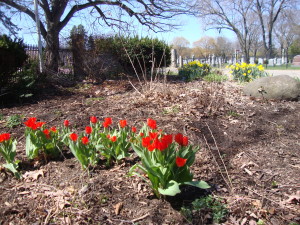
Until recently, flower beds at the front entrance of Forest Hill were maintained by a volunteer. They are currently being cared for by Olbrich Botanical Gardens, another arm of the Madison Parks Department. Photo by Claire S. Bjork.
Designing and implementing plantings at a cemetery is similar in many ways to home gardening, but there are some special considerations. Many friends and family members who take on the responsibility of caring for the graves of their loved ones prefer to use plants that require relatively little maintenance. Perennials, biennials, annuals, and even cut flowers are all used to demonstrate care, aesthetic beauty, and perhaps provide a glimpse into the life of the deceased person. While there is a tradition of ascribing emotions and traits to various plants known as the “language of flowers,” many plants are selected for their practical and aesthetic qualities, as well as their significance to the deceased or his or her family.
Forest Hill officials do not plant or maintain perennial or annual flowering plants, but will occasionally intervene in instances where graveside plantings become overgrown (some species, such as hostas and yews, can grow up and around gravestones and obstruct walkways between graves).
Current regulations for grave decoration include prohibitions on “spiny, prickly, thorny or spreading shrubs and bushes,” as well as shepherd hooks and other instruments for suspending potted plants. Further, the policy permits floral ground plantings only in front of the memorial and states that they cannot spread more than six to eight inches from it. Holiday wreaths and artificial flowers are permitted on graves only in the winter months (typically, November 1 to March 15).
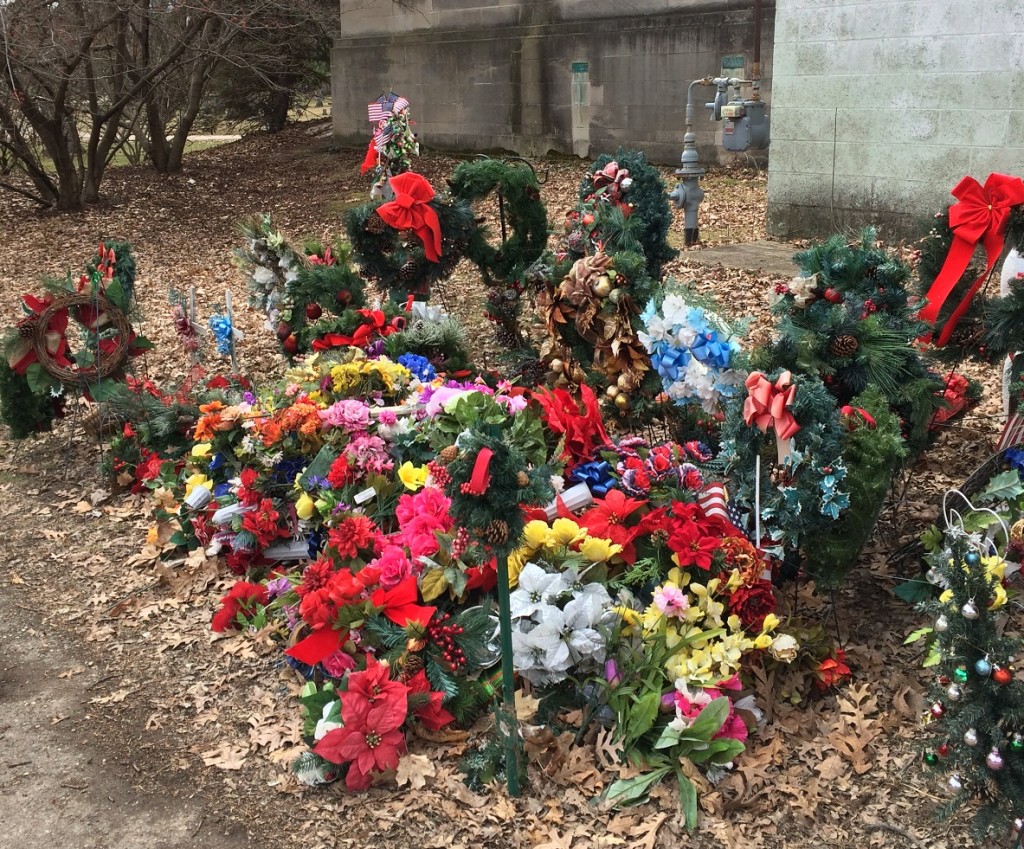
Artificial flowers and wreaths are gathered from graves and stored on site after the March deadline for removal. Photo by Adrienne Hagen.
The Soldiers’ Lot, which is owned by the federal government, overseen by the National Park Service and Department of Veterans Affairs, and managed by Wood National Cemetery, has slightly different regulations. According to their ‘Floral/Grounds Policy,’ permanent plantings are not permitted, and “natural cut flowers…will be removed when they become unsightly or when it becomes necessary to facilitate cemetery operations such as mowing.” ((National Park Service (n.d.) Forest Hill Cemetery Soldiers’ Lot: Madison, WI. Retrieved from http://www.nps.gov/nr/travel/national_cemeteries/Wisconsin/Forest_Hill_Cemetery_Soldiers_Lot.html ))
Landscaping Scenes FROM FOREST HILL
Winter Trees
Forest Hill’s landscaping is striking year-round. The general layout of the space is easier to see when the leaves have fallen. Scroll through the gallery below for a perspective from the winter months.
Spring Flowers
Splashes of color adorn Forest Hill in the early spring, when bulbs and some other perennials produce their first blooms. When the threat of frost passes, visitors begin to plant vibrant annuals like pansies and snapdragons.
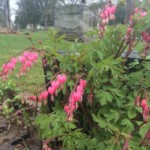
Trees and Shrubs
Trees and shrubs have also been planted by grave markers, although planting a tree or shrub at this point in time would not comply with cemetery space restrictions. Roses are one of the most well-known shrubs to be planted by graves. Also common are evergreen shrubs, such as yew, and in some cases small evergreen trees.
Landscaping without Planting
Planting design around graves is also enhanced by the addition of cut flowers, plastic or silk flowers, wreaths, and artifacts of significance like statues, crosses, or arranged stones. Many individual designs do not strictly adhere to the planting rules in Forest Hill, but they are often left undisturbed.
OTHER COMMON Plants you may see in Forest Hill Cemetery include:
Plants that provide dense foliage, which can shade out weeds or cover other plant debris, are often desirable at plots that can only be tended occasionally. One of the most popular examples of this is hosta, which comes in a wide variety of leaf and flower types. Hostas remain lush and green throughout most of the growing season, and also produce lavender to white blooms in the spring.
Daylilies are often used for their lush foliage and abundant blooms. While the individual flowers bloom for only a day, there are many on a single plant, providing color throughout the entire growing season. They are also drought-tolerant and hardy in many soil types. Their flowers can be found in many colors.
Red, white, and blue flowers are commonly used at military graves or other demonstrations of American patriotism. Geraniums are one of the most common red flowers, because of their vibrant shade yet low maintenance requirements. Lobelia is a commonly used blue or white flower, and its trailing stems can tumble artfully out of a planter, over a ledge, or across the ground, providing an inviting foreground. Other popular blue flowers are ageratum and salvia. Alyssum is a commonly used white flower.
Some other common annual flowers in midwest gardening that you might find in the cemetery:
- Snapdragon
- Marigold
- Salvia
- Pansies
- Begonia
- Zinnia
- Impatiens
- Petunia
- Cosmos
- Gerbera Daisy
- Dianthus
- Portulaca
Native perennials are not as common in graveside landscaping, but they offer a naturalistic feel very much in keeping with the romantic roots of Forest Hill. Examples of the following plants may be seen in Forest Hill:
While many of the plantings offered by loved ones are a very personal demonstration, the efforts of individuals can also come together to create community expressions. Often a central feature of a section within the cemetery, these communal landscaping features give the impression of various neighborhoods throughout the site. In addition to enhancing the sense of orientation throughout the various sections of the site, they suggest a coordination and commonality of experience between people who wish to create and tend to a beautiful, sacred space that holds their departed.
Acknowledgments
Laura Bauer, Forest Hill Cemetery Supervisor, and Karen Thompson, Program Assistant, for their insights on cemetery planting and maintenance
Selected Resources
Finney, P. J. (2012). Landscape architecture and the ‘rural’ cemetery movement. Resources in Agriculture, 31(4).
Goodnoe, J. (2013, November). Historic landscape cemeteries: Forest Hills Cemetery. Presentation for the American Society of Landscape Architects Annual Meeting and Expo, Boston, MA.
Linden-Ward, B. (1989). Strange but genteel pleasure grounds: Tourist and leisure uses of nineteenth century rural cemeteries. In R. Meyer (Ed.) Cemeteries and Gravemarkers: Voices of American Cultures. Ann Arbor: University of Michigan Research Press.
Sloane, D. C. (1995). The Last Great Necessity: Cemeteries in American History (Creating the North American Landscape). Baltimore: The Johns Hopkins University Press.
